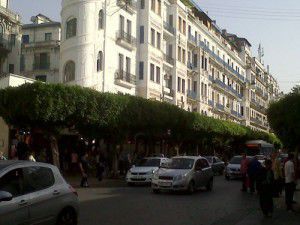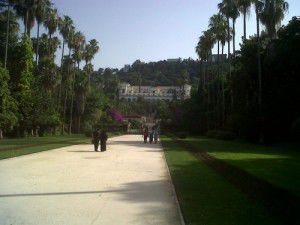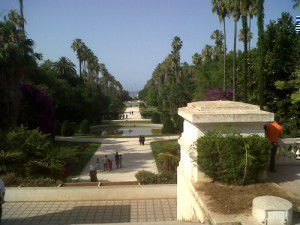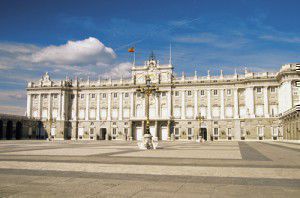10 reasons to visit… Algiers
I must admit that Algeria does not feature highly among people’s bucket list destinations.
While most tourists visiting the region flock to Egypt or Tunisia, Algeria is still very much off the beaten track. Nor does it help that it has attracted a rather bad press over the last year or so: much of the country is a security risk and the FCO advises against all travel to half of the Algeria, and all but essential travel to much of the rest.
Chickened out? Well, there is always its next door neighbour Morocco, which admittedly has done much to develop its tourist industry over the years.
‘Ah but I’ve been there already’, you say, ‘I’ve stayed in a posh riad, I’ve had a ride on a camel and I’ve stocked up on more of those pointy slippers than I’ll ever need.’
Quite. So you’re looking for the real deal, are you? Well, the good news is that Algiers, the capital, is very much worth the detour, untouched by Easyjet, and better still, firmly in the ‘OK to visit, but be careful’ bit of the country. I was lucky enough to go twice, and here I am writing this: all bodily parts present and correct, wallet intact, and dignity unscathed.
As it happens, I was working on a project with one of the government ministries. This meant that I was fortunate enough to be met at the airport and whisked through immigration and customs in seconds. I also benefited from a security detail which picked me up and accompanied me wherever I went: a pair of friendly enough goons, wearing shades and Blues Brothers suits (sans hats), constantly tailing us in a slightly scruffy VW Polo – not a Bluesmobile.
So here are my ten reasons to visit Algiers (and a bit of the surrounding area):
1. The city centre
Algiers has a faded, run down beauty. The centre of the city is full of white stuccoed buildings in the French colonial style and you’ll love exploring the up-and-down streets and avenues. Pack a pair of stout walking shoes though, as it’s a hilly place. And as you take a break, sipping a coffee and people watching at one of the many excellent cafes dotted around town, you may be wondering where all the tourists have gone. Don’t worry: the last ones left circa 1962, so you really will have the place to yourself.
2. The view
You may find yourself in accommodation higher up and somewhat away from the city centre, with the city stretching out below you. Not for nothing is the city called ‘Alger la Blanche’.
3. Public transport
I found a little cable car that takes you down the hill (i.e. from the residential suburbs to the city centre) to the sea and Botanic Garden in just three minutes. There’s also a one-line metro that crosses the city, which, when I used it, was virtually empty. I wondered whether people had in fact been told it had recently opened – or maybe they simply refused to pay the 15p fare.
4. Cheap fuel
Petrol in Algiers costs only around 10p per litre. No, this is not a misprint for 110p. Algeria is, after all, still one of the world’s leading oil producers.
5. No retail chains
Should you require a fix from KFC, McDonalds, Zara, or any other global retailer for that matter, please leave Algiers immediately. To remind you, this is not Morocco. However, with your 4 X 4 filled up with 10p petrol you could probably drive there.
6. The food
If you enjoy your French food, you might like Algiers’ version of it. The seafood is excellent, especially when washed down with a glass of Oran wine, which is not bad at all. Alternatively, if you enjoy your coucous you’ll love the Algerian varieties. Do not expect Michelin star joints: most eateries are small and family run.
By the way, you will need to hone either your French or Arabic speaking skills when you negotiate your way around town, as very few people speak English. I strongly suggest a purchase of uTalk prior to departure.
7. The treats
Do you have a sweet tooth? There are countless well stocked patisseries wherever you look, with everything from tiny sugar dusted and intricately decorated almondy cakes to classic croissants on display.
8. Le Jardin d’Essais du Hamma
The botanical garden, Le Jardin d’Essais du Hamma, is lovely: classically designed, it is formal, tropical and a respite from the heat, especially if you’re visiting during the summer.
9. Tipasa
One day we were taken along the coast to the sleepy little seaside town of Tipasa, which goes back 2,000 years, and where it is possible to visit the remains of the Roman city. In fact Tipasa became one of the most important ports in Ancient Rome.
10. Notre Dame d’Afrique
If you are determined to venture high enough in the city you’ll find Notre Dame d’Afrique, a 19th century Catholic church, which is an official monument and commands views of the Bay of Algiers and the harbour. Its architecture is fascinating: a successful blend of Eastern and Western influences.
I can’t end my snapshot of Algiers without a quote from one of its best known sons. In his 1936 essay, ‘A Summer in Algiers,’ Albert Camus wrote: ‘In Algiers one loves the ordinary places: the sea at the end of every street, a certain volume of sunlight…’ What more can you ask for?
Steve
Why learn Mandarin Chinese?
In Europe and the United States alike, a growing interest in Mandarin Chinese is leading to big changes in public and private education, with various schools for adults and children now incorporating this language into their curriculum. Many parents are currently encouraging their children, aged as young as four or five, to learn Mandarin, in an attempt to boost their prospects in the face of an increasingly competitive workforce.
Chinese growth
Despite a marked increase in popularity of Mandarin Chinese, it is interesting to view a spate of news articles and blogs advising adults and children alike not to bother learning this challenging language. Fluency in this language is impossible, their authors say, without spending many years in China; Mandarin (which utilises over 2,000 characters) is too difficult to learn in one’s free time; the tonality of the language (an array of pitches are used to convey different meanings) is a hurdle most students will fail to overcome. Even eight hours weekly spent on the subject, they claim, is not enough for top-grade fluency to be achieved.
Yet the statistics cannot be argued with: currently, some 40 million foreign students are studying Mandarin in China and by the year 2020, the Chinese government predicts that this number will rise to 100 million. According to Malaysia-chronicle.com, ‘China is now the number one producer of wind and solar power in the entire globe’. It is also the number one nation in the world in terms of trading when import and export totals are added; it boasts more foreign currency reserves than any other country; China consumes more energy than the U.S. and is the leading manufacturer of goods. There is no doubt that the study of the Chinese language can open many doors, many of which are simply not immediately foreseeable. Owing precisely to the difficulty of Chinese, children have a better chance at achieving a good conversational level if they start young. Moreover, bilingualism is not the only valid goal for budding students; even having an intermediate speaking level can go a long way in sectors such as the tourism industry.
Increase in Chinese tourism
Recent developments show the growth of Chinese investment in Europe. In late 2013, Chinese Premier, Li Keqiang, attended a Sino-CEE summit in Romania, where he and dignitaries from 16 other countries pledged to forge tighter economic ties in the near future. Chinese tourism to Europe is also on the rise, with countries like Spain receiving some 33 per cent more visitors in 2013 than in 2012. Many Chinese tourists favour countries like Spain and Italy as popular tourist destinations. As noted by planetcruise.co.uk, the Mediterranean is one of the ‘most popular cruising destinations’ for tourists from across the globe. In addition to economic reasons, there are more factors attracting children and adults alike to hone their skills in Mandarin. Recent studies indicate that speaking this language has an entirely different effect on the brain than speaking other languages. The study, undertaken by researchers at the Wellcome Trust in the UK, has revealed that the tones, sound and complicated characters used in Mandarin Chinese employ both temporal lobes in the brain (speakers use only the left temporal lobe for the English language). As Languageboat.com states, ‘learning Chinese may train a host of cognitive abilities not utilised in the study of other languages’.
It is hardly a source of surprise to find that learning Mandarin has such vastly different effects on the brain than other languages, all of which descend from a system developed in Mesopotamia thousands of years ago. The origins of the Chinese language are of a completely different nature and although learning this language for the first time can undoubtedly be time-consuming and challenging, it is also an entertaining and, some would say, beautiful, melodic way to boost one’s economic future and brain power.
Eve Pearce
The beginner’s guide to London
As London welcomes visitors from all over the world this week, we’ve put together our own guide to the city, with a selection of hints and tips to help you feel like a local…
While you’re here
– Why not take the River Bus from Putney to Blackfriars, then on to Greenwich? It’s a fast and comfortable way to cross the city, with amazing views – and no traffic jams!
– A visit to Shakespeare’s Globe will set you back just £5 for a standing ticket and is well worth it, as long as the sun’s shining… Or you could see a show in the West End – there are discount ticket booths in Leicester Square and Covent Garden where you can buy tickets for the same day.
– Go and take a look at The Shard – the tallest building in Western Europe, which has just opened near London Bridge (be prepared for a sore neck). From next year visitors will be able to travel to the top and take in the amazing views – but in the meantime, here’s a website that lets you see what you’re missing. It really is pretty special.
– If you fancy getting out of the city centre, Richmond Park and Kew Gardens are lovely – although not far from town, you’ll feel like you’re in the countryside. At Richmond, you can even see their famous deer herd.
– London boasts some fantastic free museums; we recommend the Science Museum, Natural History Museum, British Museum and the Tate Galleries, but there are plenty of others to choose from.
Useful tips
– If you’re not going far, don’t take the London Underground (also known as the Tube) – you’ll find it’s much quicker, cheaper and cooler to stay at street level and walk. This is particularly true of stations on or near the Circle Line so don’t get caught out! You can’t go too far without stumbling across a station, and there are maps pretty much everywhere, so it’s quite hard to get lost. But if you are travelling on the Tube, get yourself an Oyster Card, it’s by far the easiest way to pay for your tickets.
– Alternatively, if you want to be able to see where you’re going, but don’t fancy the bus, try hiring a ‘Boris Bike’ (named after Mayor of London, Boris Johnson, in case you were wondering). You can just pay and go, then when you’re finished, return the bike to any of the docking stations located around London – no need to bring it back to where you started.
– Most people don’t really talk in Cockney Rhyming Slang, so if you try addressing someone as your ‘china plate’ you may get some funny looks. But then again, we don’t all talk like The Queen, either. Terribly sorry, old bean.
– To feel like a real Londoner, just roll your eyes and say to random strangers, ‘Well at least the sun’s come out at last.’ You’ll fit right in.
– On a similar note, do remember to come prepared for all weathers – a typical bag should contain sun cream and sunglasses as well as an umbrella and some warm layers of clothing.
– And finally, food – we have some strange names for our dishes, so be prepared. For instance, black pudding is not, in fact, a pudding but a type of sausage (and something of an acquired taste). Eton mess sounds horrible but is actually a very tasty dessert featuring strawberries, meringue and cream. And toad in the hole does not contain any toads. Honest.
Most importantly, we hope you enjoy your visit! And don’t be afraid to ask the locals for help – we Brits may seem a bit grumpy (especially during rush hour) but underneath we’re really very nice people…
Are you a Londoner with some useful advice? Or maybe you’re visiting and have already discovered a hidden gem? Please share them in the comments!
Liz and the EuroTalk team
A Lonely Planet?
Ask your grandparents where they went on their honeymoon and the vast majority will answer that they went to some seaside town within their own country. My grandparents for instance went to Scunthorpe, and by all accounts had a brilliant time. Now look at the destinations of the people who have recently been married around you, or those just heading away for a trendy city break or backpacking around the globe. Just in our office alone I am sure we can cover most of a world map with little flags signifying the countries we have visited. My point? The world appears to be shrinking and with it comes a certain amount of damage to areas of unprecedented beauty and to some of the many wonders of the world.
 In certain cases an increase in popularity or accessibility can lead to a few oddities, and fun, if unsympathetic activities. For example, in China at the UNESCO protected site of Mutianyu, what better way to place yourself in the shoes, or sandals, of the Mongol hordes than tobogganing down the side of the Great Wall of China? The same occurs at the site of the bridge over the river Kwai. The museum explains the history of the Burmese railroad, the numbers who died in its construction and the events portrayed in the 1957 film. You can then ride across the bridge on a traditional garishly rainbow coloured, road worthy train. Small gripes I know but are we not losing the significance of these sites by diluting them with fairground distractions? Or do these attractions simply add to the entertainment value of an area?
In certain cases an increase in popularity or accessibility can lead to a few oddities, and fun, if unsympathetic activities. For example, in China at the UNESCO protected site of Mutianyu, what better way to place yourself in the shoes, or sandals, of the Mongol hordes than tobogganing down the side of the Great Wall of China? The same occurs at the site of the bridge over the river Kwai. The museum explains the history of the Burmese railroad, the numbers who died in its construction and the events portrayed in the 1957 film. You can then ride across the bridge on a traditional garishly rainbow coloured, road worthy train. Small gripes I know but are we not losing the significance of these sites by diluting them with fairground distractions? Or do these attractions simply add to the entertainment value of an area?
In Thailand I also visited Koh Phi Phi, a small island chosen as the location of The Beach, a Leonardo Dicaprio film and book by Alex Garland, which portrayed a utopian island experience far away from the western confines of the mass backpacker route. 
Ironically the setting for this isolated paradise is now one of the most visited areas in Thailand and ’the Beach’ is now thronged with noisy tourists; the Andaman waters are now gleaming because of the residue left from the flotilla of tourist-packed speed boats that arrive at the location twice a day. Despite the numbers of tourists, ‘the Beach’ topped almost all guide books as a must-see, and whether I had been there was the first question fielded from friends at home. In the end it was simply a ticked box rather than a once in a lifetime experience.
What I am trying to determine from these small examples are the opinions of other tourists and travellers. I wanted to go somewhere because it was famous. People have heard of ‘the Beach’ and everyone knows about the Great Wall of China. But should the accessibility to these locations be limited? Is accessibility a good thing?
The example I want to finish on is Tibet. An area known by most people as a far outpost of China, an area little visited due to its isolation from, well, everywhere! It’s a spiritual area isolated from the western world, it takes two days by train to get there. With China planning a high-speed rail link to the area, how long will it be before you can toboggan from the top of Lhasa’s famous monastery?
Glyn













